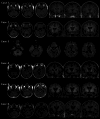Semantic variant primary progressive aphasia with ANXA11 p.D40G
- PMID: 40042459
- PMCID: PMC11881632
- DOI: 10.1002/alz.14566
Semantic variant primary progressive aphasia with ANXA11 p.D40G
Abstract
Introduction: Pathogenic variants of annexin A11 (ANXA11) have been identified in patients with amyotrophic lateral sclerosis (ALS) with or without frontotemporal dementia (FTD). We explored ANXA11 pathogenic variants in a Korean FTD cohort to investigate the prevalence and the role of ANXA11 variation in FTD.
Methods: We used next-generation sequencing (NGS) to search for pathogenic variants in ANXA11 in two nationwide FTD cohorts in Korea.
Results: We identified a pathogenic variant in ANXA11, c.119A > G (p.D40G), in six patients with semantic variant primary progressive aphasia (svPPA), representing 5.5% of the svPPA cohort (6/109), and representing 2.3% of the FTD cohort overall (6/259). Only one patient later developed features suggestive of ALS.
Discussion: This study links a rare variant in ANXA11 to a sporadic clinical syndrome in which specific TAR DNA-binding protein-43 (TDP-43) forms an obligate co-fibril with annexin A11. The variant, p.D40G, lies within the N-terminal portion of annexin A11's TDP-43 type C interacting domain, suggesting that genetic variation in that region may promote co-fibrillization.
Highlights: The pathogenic variant of annexin A11 (ANXA11I) is linked to frontotemporal dementia (FTD) syndrome. ANXA11 (p.D40G) may be one of the possible genetic causes of semantic variant primary progressive aphasia (svPPA). ANXA11 (p.D40G) may enhance heteromeric amyloid filaments of annexin A11 and TDP-43, promoting frontotemporal lobar degeneration with TAR DNA-binding protein-43 (TDP-43) inclusions (FTLD-TDP) type C.
Keywords: ANXA11; FTLD‐TDP type C; TDP‐43; annexin A11; clinical genetics; frontotemporal dementia (FTD); semantic variant primary progressive aphasia (svPPA).
© 2025 The Author(s). Alzheimer's & Dementia published by Wiley Periodicals LLC on behalf of Alzheimer's Association.
Conflict of interest statement
The authors declare no conflict of interest. Author disclosures are available in the Supporting Information.
Figures


References
-
- Rohrer JD, Boxer AL. The frontotemporal dementia prevention initiative: linking together genetic frontotemporal dementia cohort studies. Adv Exp Med Biol. 2021;1281:113‐121. - PubMed
-
- Tsai P‐C, Liao Y‐C, Jih K‐Y, Soong B‐W, Lin K‐P, Lee Y‐C. Genetic analysis of ANXA11 variants in a Han Chinese cohort with amyotrophic lateral sclerosis in Taiwan. Neurobiol Aging. 2018;72:188.e1‐188.e2. - PubMed
MeSH terms
Substances
Grants and funding
LinkOut - more resources
Full Text Sources
Miscellaneous

